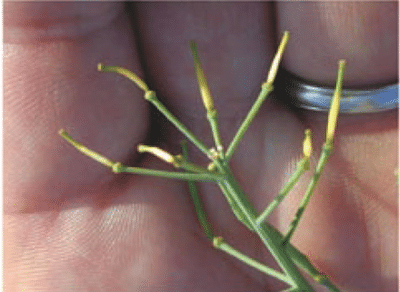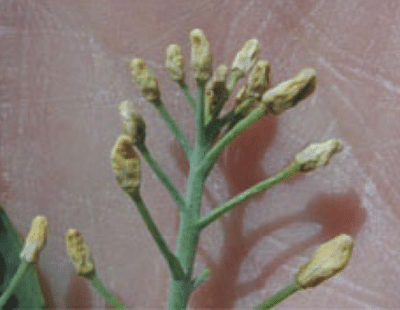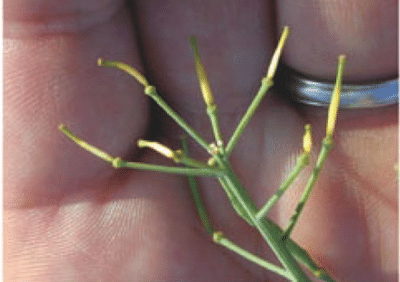

Missing pods can result from any stress on the plant. Any stress can inhibit proper fertilization of the flowers. In many cases the cause may seem obvious, but it is often a good idea to investigate further to ensure there are no other contributing factors.
Abortion of flowers and pods is natural. Research has shown that typically only 40-55% of the flowers produced on a plant develop into productive pods. Here are key reasons for abortion:
1) Heat stress is most often associated with temperatures above 25 ºC during flowering but heat stress can occur during early pod filling as well. Research has shown that the plants are more sensitive to heat stress at early flowering than at pod fill. Heat stress tends to be worse in drought conditions. Heat combined with adequate rain and high humidity will have a reduced impact.
2) Moisture Stress. Too dry and too wet can both cause blanks. Excess water impacts pod formation due to several nutrient aspects including nutrient loss, lack of oxygen reducing root uptake of nutrients, and nutrient deficiency inducing premature senescence via hormones. Soil that’s waterlogged for three days or more at flowering will reduce the number of pods per branch as well as the number of seeds per pod.
3) Heavy rain or irrigation can damage or knock flowers off the stems and reduce pollination, resulting in blanks. Later formed flowers however, often compensate for this damage.
4) Insects can either eat the buds or damage flower buds while feeding for pollen. In normal years, the plants will compensate but in dryer years, the insects can be yield robbers at the early bud stage. Sweep net sampling and plant examination at the early bud stage is encouraged. Insects that feed on flowers include diamondback moth larvae, lygus bugs, alfalfa loopers, and cabbage seedpod weevils.
5) Herbicide stress. When herbicide spraying is delayed until the early bud stage, this puts stress on the crop at a time that can result in aborted flowers or pods. In normal conditions, the plant can compensate by producing more flowers. However, when combined with another stress such as drought or nutrient deficiency, the plants may be less able to compensate and yield loss can occur.
6) Fertility. Nitrogen (N), sulphur (S) and boron (B) deficiencies can cause flower blast, pod abortion or poor pod filling. Of these, S deficiency is the most likely to cause flower blast under field conditions. With N and S, you would likely see other deficiency symptoms such as poor branching, short height, colour. In some cases, lack of fertility during dry years can occur where roots are having trouble extracting sulphate from the soil profile. The result is typically aborted pods, even with adequate sulphate sulphur application. Once moisture is available and the roots can acquire adequate amounts of sulphur, flowering and pod formation often return to normal.
Click here for the full CCC factsheet on this topic.

